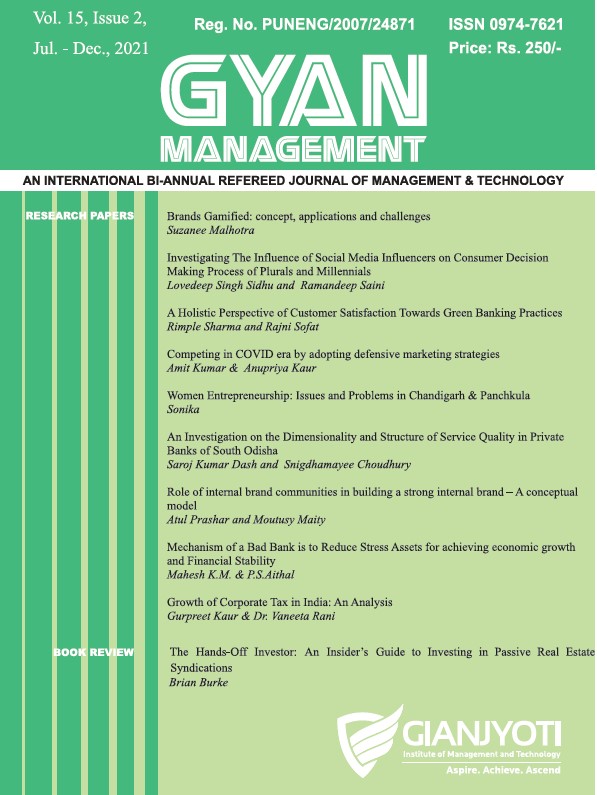Servant Leadership Characteristics- Testing The Relability of Scale in Select Government Hospital
DOI:
https://doi.org/10.48165/gmj.2023.18.2.3Keywords:
Servant Leadership, ReliabilityAbstract
Purpose: The study is an attempt to test the standardization of a foreign scale on Servant Leadership Characteristics that is ‘The Organizational Leadership Assessment’ (OLA) (revised) evolved by James Alan Laub (1999) in selected Hospital Organization in Panchkula (India). Design/Methodology/ Approach: Specifically, as defined by James Alan Laub, the dimensions which are six in number that is a.) Values People, b.) Develops People, c.) Builds Community, d.) Displays Authenticity, e.) Provides Leadership and f.) Shares Leadership were used to build a servant leadership scale. The questionnaire was filled by 100 respondents from Panchkula (India). Further to test the reli ability and validity of it, Cronbach’s Alpha and Measures of Dispersion were used. Findings: The 6 dimensional measure of 60-items instrument main tains the Cronbach’s alpha for Servant leadership dimensions ranging between 0.879 - 0.921 which is above the significance level of 0.60. All the items have reliability above prescribed significance level, i.e.0.60. Practical Implication: It is anticipated that the Organizational Leadership Assessment will function as a valuable and significant resource for doing more study in various fields in the future.
Downloads
References
Anderson, J. (2008). The writings of Robert K. Greenleaf: An interpretive analysis and the future of ser vant leadership. In Servant Leadership Research Roundtable. Regent University.
Armstrong, M. (2006). A handbook of human resource management practice. Kogan Page Publishers, London, 264.
Barbuto, J. E., & Gifford, G. T. (2010).Examining gender differences of servant leadership: An analysis of the agentic and communal properties of the Servant Leadership Questionnaire. Journal of Leadership Education, 9(2), 4-21.
Barbuto Jr, J. E., & Wheeler, D. W. (2006). Scale devel opment and construct clarification of servant lead ership. Group & Organization Management, 31(3), 300-326.
Bellet, Paul S.; Michael J. Maloney (1991).”The importance of empathy as an interviewing skill in medicine”. The Journal of the American Medical Association, 226 (13), 1831–1832.
Belsky, J. (2016). Servant leadership can save the health care profession. Smart business online. August 26, 2016.
Belton, L. (2017). Servant Leadership: A journey, not a race. Health Management.org. 17(4), 268-270. Bovenzi, G. (2016). Servant Leadership and Cultural Characteristics as Predictors of Follower Engagement. Campbell, P. T., &Rudisill, P. T. (2005). Servant leadership: A critical component for nurse leaders. Nurse Leader, 3(3), 27–29.
Cerit, Y. (2009). The effects of servant leadership behaviours of school principals on teachers’ job sat isfaction. Educational Management Administration & Leadership, 37(5), 600-623.
Cerit, Y. (2010). The effects of servant leadership on teach ers’ organizational commitment in primary schools in Turkey. International Journal of Leadership in Education, 13(3), 301-317.
Earnhardt, M. P. (2008). Testing a servant leadership theory among United States military members. Emerging Leadership Journeys, 1(2), 14.
Eva, N., Robin, M., Sendjaya, S., Van Dierendonck, D., &Liden, R. C. (2019). Servant leadership: A sys tematic review and call for future research. The Leadership Quarterly, 30(1), 111-132.
Farmer, S. W. (2010). Servant leadership attributes in senior military officers: A quantitative study exam ining demographic factors (Doctoral dissertation, North Central University).
Foster, B. A. (2000). Barriers to servant leadership: Perceived organizational elements that impede ser vant leader effectiveness. The Fielding Institute.
Greenleaf, R. K. (1970). The servant as leader (an essay). Greenleaf Organization.
Greenleaf, R. K. (2002). Servant leadership: A journey into the nature of legitimate power and greatness. Paulist Press.
Hunter, E. M., Neubert, M. J., Perry, S. J., Witt, L. A., Penney, L. M., & Weinberger, E. (2013). Servant leaders inspire servant followers: Antecedents and outcomes for employees and the organization. The Leadership Quarterly, 24(2), 316-331.
dia facing shortage of 600,000 doctors, 2 million nurses: Studyavailableat https://economictimes.indiatimes. com/industry/healthcare/biotech/healthcare/india viewed on 5th November 2019.
Joseph, E. E., & Winston, B. E. (2005).A correlation of servant leadership, leader trust, and organizational trust. Leadership & Organization Development Journal, 26(1), 6-22.
Mahon, D. (2021). Can using a servant-leadership model of supervision mitigate against burnout and secondary trauma in the health and social care sector?. Leadership in Health Services, Vol. 34 No. 2, pp. 198-214.
Patterson, K. A. (2003). Servant leadership: A theoretical model (Doctoral dissertation, Regent University). Patton, M. Q. (2002). Qualitative research and evaluation methods .Thousand Oakes.
Population of India available at http://statisticstimes.com/ demographics/population-of-india.php viewed on 5th September 2023.
Robbins, S. P., & Judge, T. (2005).Organizational Behavior, 11th ed., Prentice-Hall, Upper Saddle River, NJ. Salameh, K. M. (2011). Servant leadership practices
among school principals in educational directorates in Jordan. International Journal of Business and Social Science, 2(22), 138-145.
Sendjaya, S. (2015). Personal and organizational excel lence through servant leadership. Australia: Springer International Publishing Switzerland.
Van Dierendonck, D., &Nuijten, I. (2011). The servant leadership survey: Development and validation of a multidimensional measure. Journal of business and psychology, 26(3), 249-267.
Wolor, C. W., Ardiansyah, A., Rofaida, R., Nurkhin, A., & Rababah, M. A. (2022). Impact of Toxic Leadership on Employee Performance. Health psychology research, 10(4).
Downloads
Published
Issue
Section
License
Copyright (c) 2024 Gyan Management Journal

This work is licensed under a Creative Commons Attribution 4.0 International License.



